Yamaha DME8i-ES, DME8o-ES, DME4io-ES User Manual
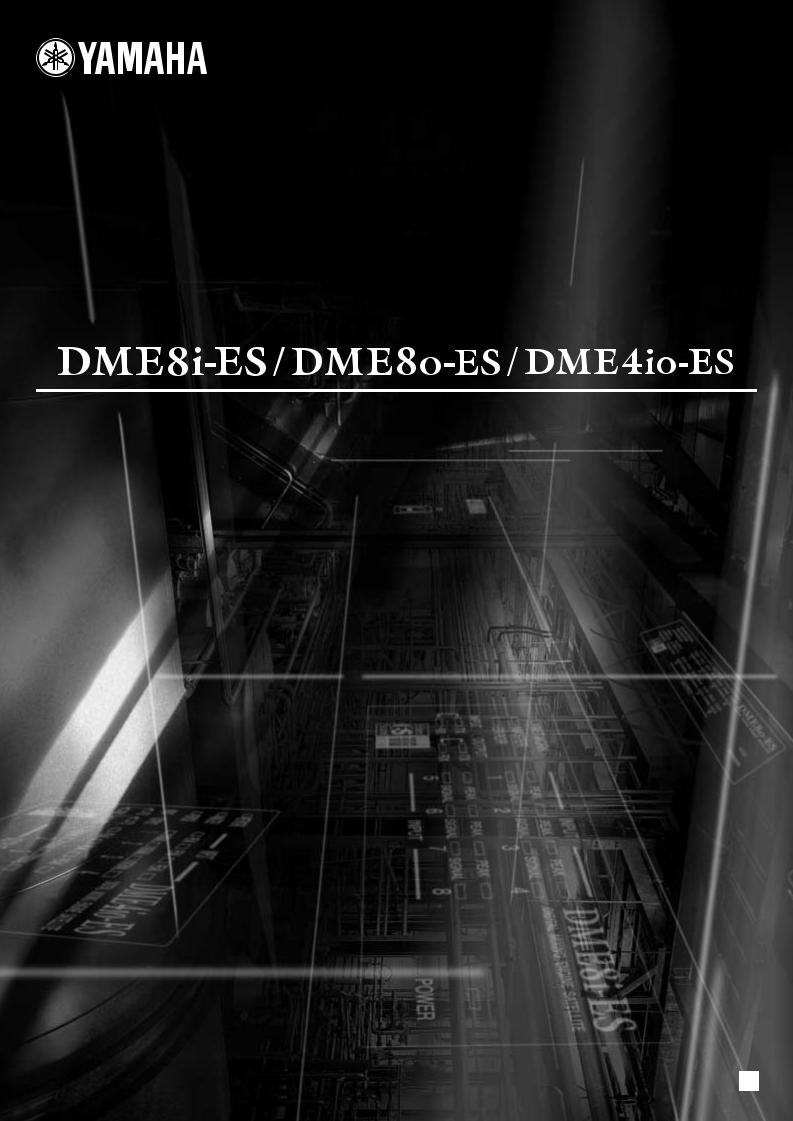
DIGITAL MIXING ENGINE SATELLITE
Owner’s Manual
EN
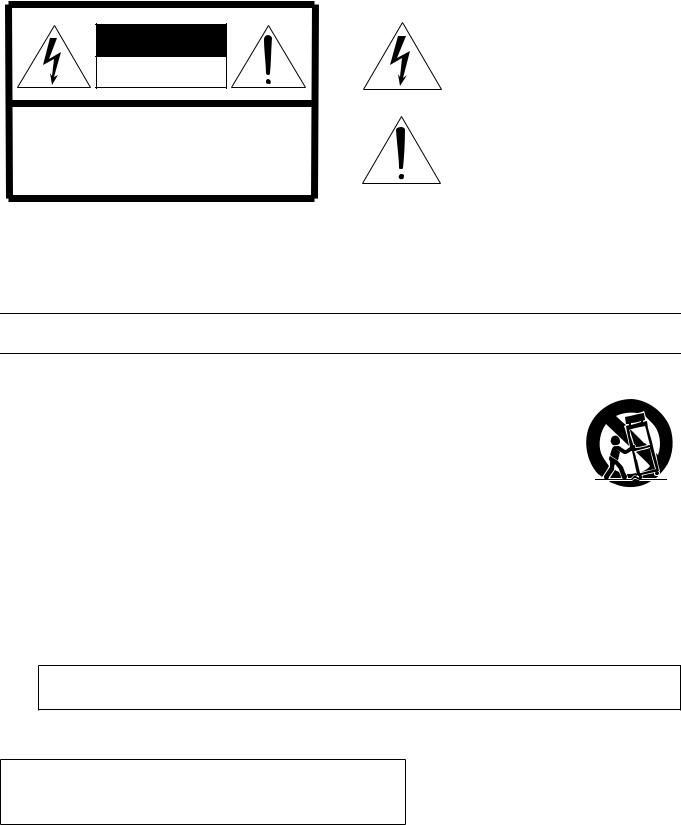
CAUTION
RISK OF ELECTRIC SHOCK
DO NOT OPEN
CAUTION: TO REDUCE THE RISK OF ELECTRIC SHOCK, DO NOT REMOVE COVER (OR BACK). NO USER-SERVICEABLE PARTS INSIDE. REFER SERVICING TO QUALIFIED SERVICE PERSONNEL.
The above warning is located on the top of the unit.
Explanation of Graphical Symbols
The lightning flash with arrowhead symbol within an equilateral triangle is intended to alert the user to the presence of uninsulated “dangerous voltage” within the product’s enclosure that may be of sufficient magnitude to constitute a risk of electric shock to persons.
The exclamation point within an equilateral triangle is intended to alert the user to the presence of important operating and maintenance (servicing) instructions in the literature accompanying the product.
IMPORTANT SAFETY INSTRUCTIONS
1Read these instructions.
2Keep these instructions.
3Heed all warnings.
4Follow all instructions.
5Do not use this apparatus near water.
6Clean only with dry cloth.
7Do not block any ventilation openings. Install in accordance with the manufacturer’s instructions.
8Do not install near any heat sources such as radiators, heat registers, stoves, or other apparatus (including amplifiers) that produce heat.
9Do not defeat the safety purpose of the polarized or grounding-type plug. A polarized plug has two blades with one wider than the other. A grounding type plug has two blades and a third grounding prong. The wide blade or the third prong are provided for your safety. If the provided plug does not fit into your outlet, consult an electrician for replacement of the obsolete outlet.
10Protect the power cord from being walked on or pinched particularly at plugs, convenience receptacles, and the point where they exit from the apparatus.
11Only use attachments/accessories specified by the manufacturer.
12Use only with the cart, stand, tripod, bracket, or table specified
by the manufacturer, or sold with the apparatus. When a cart is used, use caution when moving the cart/apparatus combination to avoid injury from tip-over.
13Unplug this apparatus during
lightning storms or when unused for long periods of time.
14Refer all servicing to qualified service personnel. Servicing is required when the apparatus has been damaged in any way, such as power-supply cord or plug is damaged, liquid has been spilled or objects have fallen into the apparatus, the apparatus has been exposed to rain or moisture, does not operate normally, or has been dropped.
WARNING
TO REDUCE THE RISK OF FIRE OR ELECTRIC SHOCK, DO NOT EXPOSE THIS APPARATUS TO RAIN OR MOISTURE.
(98-6500)
This product contains a battery that contains perchlorate material.
Perchlorate Material—special handling may apply,
See www.dtsc.ca.gov/hazardouswaste/perchlorate.
* This applies only to products distributed by YAMAHA CORPORATION OF AMERICA. |
(Perchlorate) |

FCC INFORMATION (U.S.A.)
1. IMPORTANT NOTICE: DO NOT MODIFY THIS UNIT! |
not guarantee that interference will not occur in all installations. If |
|
This product, when installed as indicated in the instructions con- |
this product is found to be the source of interference, which can be |
|
tained in this manual, meets FCC requirements. Modifications not |
determined by turning the unit “OFF” and “ON”, please try to elimi- |
|
expressly approved by Yamaha may void your authority, granted by |
nate the problem by using one of the following measures: |
|
the FCC, to use the product. |
Relocate either this product or the device that is being affected by |
|
2. IMPORTANT: When connecting this product to accessories and/ |
the interference. |
|
or another product use only high quality shielded cables. Cable/s |
Utilize power outlets that are on different branch (circuit breaker or |
|
supplied with this product MUST be used. Follow all installation |
fuse) circuits or install AC line filter/s. |
|
instructions. Failure to follow instructions could void your FCC |
In the case of radio or TV interference, relocate/reorient the |
|
authorization to use this product in the USA. |
||
antenna. If the antenna lead-in is 300 ohm ribbon lead, change the |
||
3. NOTE: This product has been tested and found to comply with the |
||
lead-in to co-axial type cable. |
||
requirements listed in FCC Regulations, Part 15 for Class “B” digital |
If these corrective measures do not produce satisfactory results, |
|
devices. Compliance with these requirements provides a reason- |
||
please contact the local retailer authorized to distribute this type of |
||
able level of assurance that your use of this product in a residential |
||
product. If you can not locate the appropriate retailer, please con- |
||
environment will not result in harmful interference with other elec- |
||
tact Yamaha Corporation of America, Electronic Service Division, |
||
tronic devices. This equipment generates/uses radio frequencies |
||
6600 Orangethorpe Ave, Buena Park, CA90620 |
||
and, if not installed and used according to the instructions found in |
||
The above statements apply ONLY to those products distributed by |
||
the users manual, may cause interference harmful to the operation |
||
Yamaha Corporation of America or its subsidiaries. |
||
of other electronic devices. Compliance with FCC regulations does |
||
|
||
|
|
|
* This applies only to products distributed by YAMAHA CORPORATION OF AMERICA. |
(class B) |
COMPLIANCE INFORMATION STATEMENT (DECLARATION OF CONFORMITY PROCEDURE)
Responsible Party : Yamaha Corporation of America
Address : 6600 Orangethorpe Ave., Buena Park, Calif.
90620
Telephone : 714-522-9011
Type of Equipment : DIGITAL MIXING ENGINE SATELLITE
Model Name : DME8i-ES/DME8o-ES/DME4io-ES
This device complies with Part 15 of the FCC Rules.
Operation is subject to the following two conditions:
1)this device may not cause harmful interference, and
2)this device must accept any interference received including interference that may cause undesired operation.
See user manual instructions if interference to radio reception is suspected.
* This applies only to products distributed by |
(FCC DoC) |
YAMAHA CORPORATION OF AMERICA. |
|
ADVARSEL!
Lithiumbatteri—Eksplosionsfare ved fejlagtig håndtering. Udskiftning må kun ske med batteri af samme fabrikat og type. Levér det brugte batteri tilbage til leverandoren.
VARNING
Explosionsfara vid felaktigt batteribyte. Använd samma batterityp eller en ekvivalent typ som rekommenderas av apparattillverkaren. Kassera använt batteri enligt fabrikantens instruktion.
VAROITUS
Paristo voi räjähtää, jos se on virheellisesti asennettu. Vaihda paristo ainoastaan laitevalmistajan suosittelemaan tyyppiin. Hävitä käytetty paristo valmistajan ohjeiden mukaisesti.
(lithium caution)
NEDERLAND / THE NETHERLANDS
•Dit apparaat bevat een lithium batterij voor geheugen back-up.
•This apparatus contains a lithium battery for memory back-up.
•Raadpleeg uw leverancier over de verwijdering van de batterij op het moment dat u het apparaat ann het einde van de levensduur afdankt of de volgende Yamaha Service Afdeiing:
Yamaha Music Nederland Service Afdeiing Kanaalweg 18-G, 3526 KL UTRECHT
Tel. 030-2828425
•For the removal of the battery at the moment of the disposal at the end of the service life please consult your retailer or Yamaha Service Center as follows:
Yamaha Music Nederland Service Center Address : Kanaalweg 18-G, 3526 KL UTRECHT
Tel : 030-2828425
•Gooi de batterij niet weg, maar lever hem in als KCA.
•Do not throw away the battery. Instead, hand it in as small chemical waste.
(lithium disposal)
IMPORTANT NOTICE FOR THE UNITED KINGDOM
Connecting the Plug and Cord
WARNING: THIS APPARATUS MUST BE EARTHED IMPORTANT. The wires in this mains lead are coloured in accordance with the following code:
GREEN-AND-YELLOW : EARTH
BLUE |
: |
NEUTRAL |
BROWN |
: |
LIVE |
As the colours of the wires in the mains lead of this apparatus may not correspond with the coloured markings identifying the terminals in your plug proceed as follows:
The wire which is coloured GREEN-and-YELLOW must be connected to the terminal in the plug which is marked by the letter E or by the safety earth symbol  or colored GREEN or GREEN-and- YELLOW.
or colored GREEN or GREEN-and- YELLOW.
The wire which is coloured BLUE must be connected to the terminal which is marked with the letter N or coloured BLACK.
The wire which is coloured BROWN must be connected to the terminal which is marked with the letter L or coloured RED.
• This applies only to products distributed by Yamaha-Kemble Music (U.K.) Ltd.(3 wires)
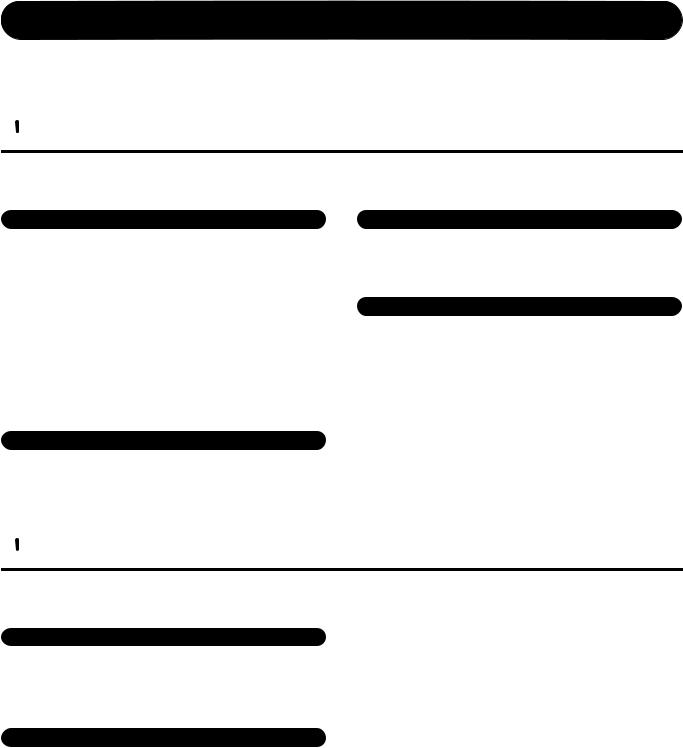
PRECAUTIONS
PLEASE READ CAREFULLY BEFORE PROCEEDING
* Please keep this manual in a safe place for future reference.
 WARNING
WARNING
Always follow the basic precautions listed below to avoid the possibility of serious injury or even death from electrical shock, short-circuiting, damages, fire or other hazards. These precautions include, but are not limited to, the following:
Power supply/Power cord
•Only use the voltage specified as correct for the device. The required voltage is printed on the name plate of the device.
•Use only the included power cord.
If you intend to use the device in an area other than in the one you purchased, the included power cord may not be compatible. Please check with your Yamaha dealer.
•Do not place the power cord near heat sources such as heaters or radiators, and do not excessively bend or otherwise damage the cord, place heavy objects on it, or place it in a position where anyone could walk on, trip over, or roll anything over it.
•Be sure to connect to an appropriate outlet with a protective grounding connection. Improper grounding can result in electrical shock.
Do not open
•Do not open the device or attempt to disassemble the internal parts or modify them in any way. The device contains no user-serviceable parts. If it should appear to be malfunctioning, discontinue use immediately and have it inspected by qualified Yamaha service personnel.
 CAUTION
CAUTION
Water warning
•Do not expose the device to rain, use it near water or in damp or wet conditions, or place containers on it containing liquids which might spill into any openings.
•Never insert or remove an electric plug with wet hands.
If you notice any abnormality
•If the power cord or plug becomes frayed or damaged, or if there is a sudden loss of sound during use of the device, or if any unusual smells or smoke should appear to be caused by it, immediately turn off the power switch, disconnect the electric plug from the outlet, and have the device inspected by qualified Yamaha service personnel.
•If this device should be dropped or damaged, immediately turn off the power switch, disconnect the electric plug from the outlet, and have the device inspected by qualified Yamaha service personnel.
Always follow the basic precautions listed below to avoid the possibility of physical injury to you or others, or damage to the device or other property. These precautions include, but are not limited to, the following:
Power supply/Power cord
•Remove the electric plug from the outlet when the device is not to be used for extended periods of time, or during electrical storms.
•When removing the electric plug from the device or an outlet, always hold the plug itself and not the cord. Pulling by the cord can damage it.
Location
•Before moving the device, remove all connected cables.
•When setting up the device, make sure that the AC outlet you are using is easily accessible. If some trouble or malfunction occurs, immediately turn off the power switch and disconnect the plug from the outlet. Even when the power switch is turned off, electricity is still flowing to the product all the minimum level. When you are not using the product for a long time, make sure to unplug the power cord from the wall AC outlet.
•If this device is to be mounted in an EIA-standard rack, leave the back of the rack open and make sure that it is at least 10 cm away from walls or surfaces. Also, if this device is to be mounted with devices that tend to generate heat, such as power amplifiers, be sure to keep an adequate gap between this device and the heat-generating devices or install ventilation panels to prevent high temperatures from developing inside this device.
Inadequate ventilation can result in overheating, possibly causing damage to the device(s), or even fire.
•If several of the devices are mounted in an EIA-compliant rack, carefully read the section “Precautions for Using a Rack-mounted DME Satellite” on page 17
•Avoid setting all equalizer controls and faders to their maximum. Depending on the condition of the connected devices, doing so may cause feedback and may damage the speakers.
•Do not expose the device to excessive dust or vibrations, or extreme cold or heat (such as in direct sunlight, near a heater, or in a car during the day) to prevent the possibility of panel disfiguration or damage to the internal components.
•Do not place the device in an unstable position where it might accidentally fall over.
•Do not block the vents. This device has ventilation holes at the rear to prevent the internal temperature from becoming too high. In particular, do not place the device on its side or upside down. Inadequate ventilation can result in overheating, possibly causing damage to the device(s), or even fire.
•Do not use the device in the vicinity of a TV, radio, stereo equipment, mobile phone, or other electric devices. Doing so may result in noise, both in the device itself and in the TV or radio next to it.
(5)-4 1/2
4 |
DME8i-ES/DME8o-ES/DME4io-ES Owner’s Manual |
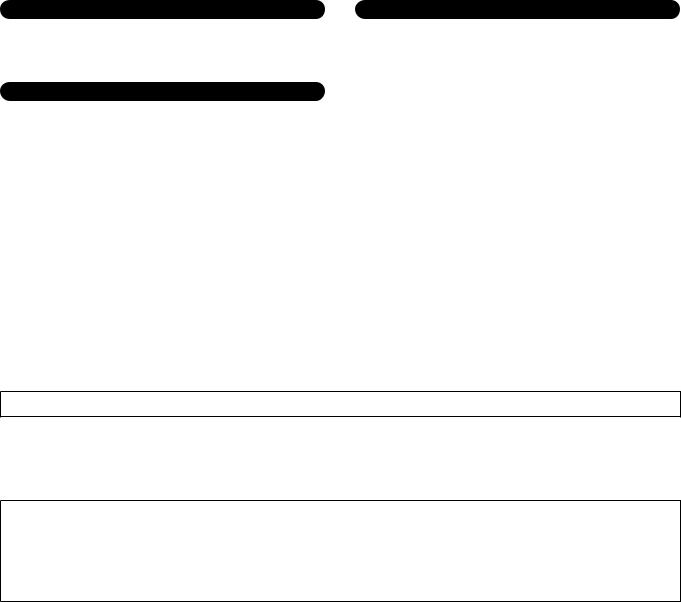
Connections
•Before connecting the device to other devices, turn off the power for all devices. Before turning the power on or off for all devices, set all volume levels to minimum.
Handling caution
•Do not insert your fingers or hands in any gaps or openings on the device.
•Avoid inserting or dropping foreign objects (paper, plastic, metal, etc.) into any gaps or openings on the device. If this happens, turn off the power immediately and unplug the power cord from the AC outlet. Then have the device inspected by qualified Yamaha service personnel.
•Do not use the device for a long period of time at a high or uncomfortable volume level, since this can cause permanent hearing loss. If you experience any hearing loss or ringing in the ears, consult a physician.
•Do not rest your weight on the device or place heavy objects on it, and avoid use excessive force on the buttons, switches or connectors.
Backup battery
•This device has a built-in backup battery. When you unplug the power cord from the AC outlet, the current scene data is retained. However, the life of the backup battery is about five years. If the battery wears out, the current scene data will be lost. When the backup battery charge becomes low, the [ERROR] indicator on the front panel blinks. In this case, save the data to a computer immediately, then ask a Yamaha dealer to replace the backup battery.
Do not turn the [POWER] switch on and off repeatedly and rapidly. Be sure to wait six seconds or more between turning the power to the unit off and then on.
The rubber feet included in this package can be attached to the speaker to prevent slippage when it is to be used on a slipper y surface.
Yamaha cannot be held responsible for damage caused by improper use or modifications to the device, or data that is lost or destroyed.
Always turn the power off when the device is not in use.
The performance of components with moving contacts, such as switches, volume controls, and connectors, deteriorates over time. Consult qualifi ed Yamaha service personnel about replacing defective components.
•Copying of the commercially available musical data including but not limited to MIDI data and/or audio data is strictly prohibited except for your personal use.
•The illustrations in this owner’s manual are for instructional purposes, and may appear somewhat different from the actual equipment.
•EtherSound is a trademark of Digigram SA.
•Ethernet is a trademark of Xerox Corporation.
•All other trademarks are the property of their respective holders and are hereby acknowledged.
(5)-4 2/2
DME8i-ES/DME8o-ES/DME4io-ES Owner’s Manual |
5 |
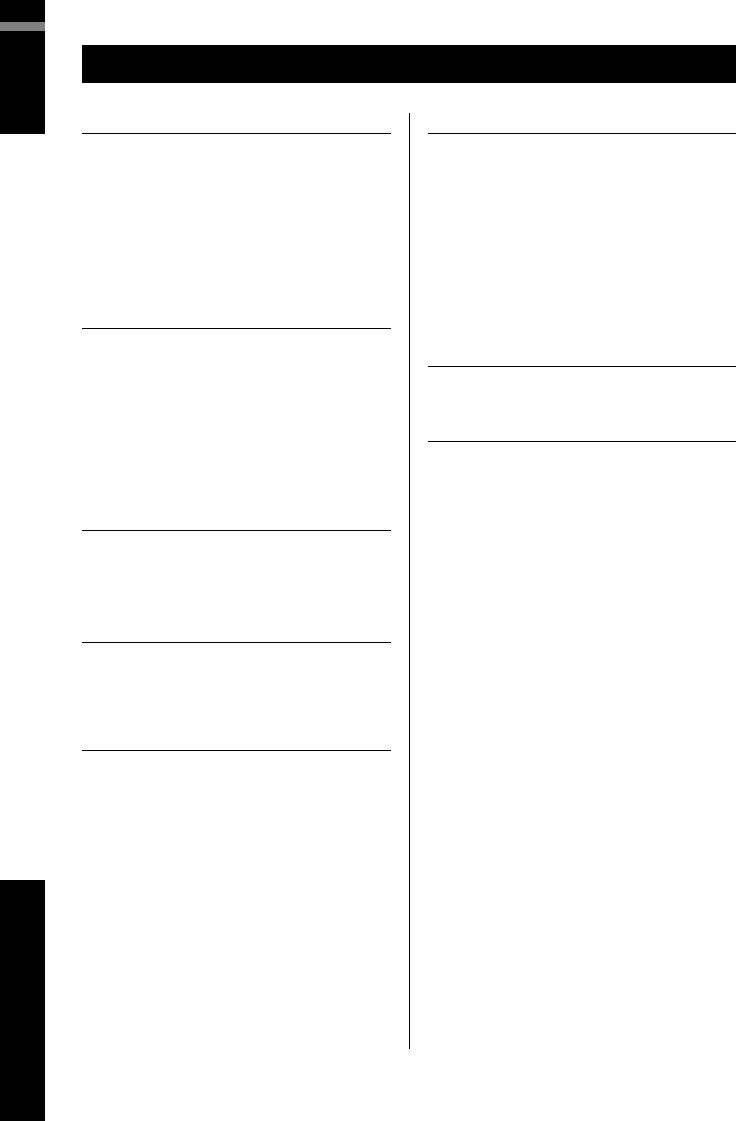
Foreword
|
|
|
|
Satellite DME the |
to Introduction |
|
|
|
|
Connectors |
and Controls |
|
|
|
|
Computer a |
Connecting |
|
to |
|
|
|
|
Connection |
I/O Audio |
|
|
|
|
Device External |
an to Connecting |
|
|
|
|
Functions Other |
|
|
|
|
|
References |
|
Contents |
|
Foreword .......................................... |
7 |
Accessories (Please make sure the following items are |
|
included in the package.)................................ |
7 |
Options........................................................................... |
7 |
About the Product Names............................................... |
7 |
About the Firmware Version ........................................... |
7 |
Preparation...................................................................... |
7 |
Connecting the AC power cord........................................... |
7 |
Turning the power on and off ............................................. |
7 |
Introduction to the DME Satellite .............. |
8 |
Differences between DME8i-ES, DME8o-ES, |
|
and DME4io-ES ............................................ |
8 |
DME Satellite Features ................................................... |
8 |
Audio System Network ................................................... |
9 |
Glossary for the DME Satellite........................................ |
9 |
Signal Types.................................................................. |
11 |
System Examples........................................................... |
12 |
About DME Designer ................................................... |
13 |
Controls and Connectors ....................... |
14 |
Front Panel ................................................................... |
14 |
Rear Panel ..................................................................... |
16 |
Precautions for Using a Rack-mounted DME Satellite .. |
17 |
Connecting to a Computer ..................... |
18 |
USB Connection........................................................... |
18 |
Network Settings............................................................... |
19 |
Ethernet Connection ([NETWORK] Connector)......... |
20 |
Audio I/O Connection ........................... |
24 |
Digital Audio Connection (EtherSound Connectors).... |
24 |
Analog Audio Connection ([INPUT] & [OUTPUT] |
|
Connectors) ................................................. |
25 |
Connecting to an External Device............. |
26 |
Remote Connection ([REMOTE] Connector).............. |
26 |
Controlling external head amplifiers |
|
from the DME Satellite......................................... |
26 |
Controlling a DME Satellite’s internal head amps |
|
from a digital mixer............................................... |
27 |
Controlling the DME Satellite from an external device...... |
27 |
EtherSound Connection (EtherSound Connectors)....... |
28 |
Controlling DME Satellite’s internal head amps |
|
from a digital mixer............................................... |
28 |
Network Connection ([NETWORK] Connectors) ....... |
29 |
GPI Connection ([GPI] Connector).............................. |
30 |
Other Functions.................................. |
31 |
Initializing the DME Satellite........................................ |
31 |
References ....................................... |
32 |
Options ......................................................................... |
32 |
ICP1.................................................................................. |
32 |
CP4SW, CP4SF, and CP1SF............................................. |
32 |
Troubleshooting............................................................ |
33 |
Component ................................................................... |
33 |
MIDI Data Format ....................................................... |
34 |
1. MIDI functions on the DME8i-ES, DME8o-ES, |
|
and DME4io-ES ................................................... |
34 |
2. MIDI Data Flow ........................................................... |
34 |
3. MIDI Setup................................................................... |
34 |
4. MIDI Format ................................................................ |
35 |
MIDI Implementation Chart ........................................ |
37 |
Display Messages........................................................... |
38 |
Error Messages................................................................... |
38 |
Warning Messages ............................................................. |
38 |
General Specifications ................................................... |
39 |
Electrical Characteristics ................................................ |
39 |
Input/Output Characteristics ........................................ |
42 |
[NETWORK] Connector (100Base-TX Ethernet, |
|
RJ-45) .......................................................... |
43 |
Dimensions ................................................................... |
44 |
Index ............................................................................. |
45 |
6 |
DME8i-ES/DME8o-ES/DME4io-ES Owner’s Manual |
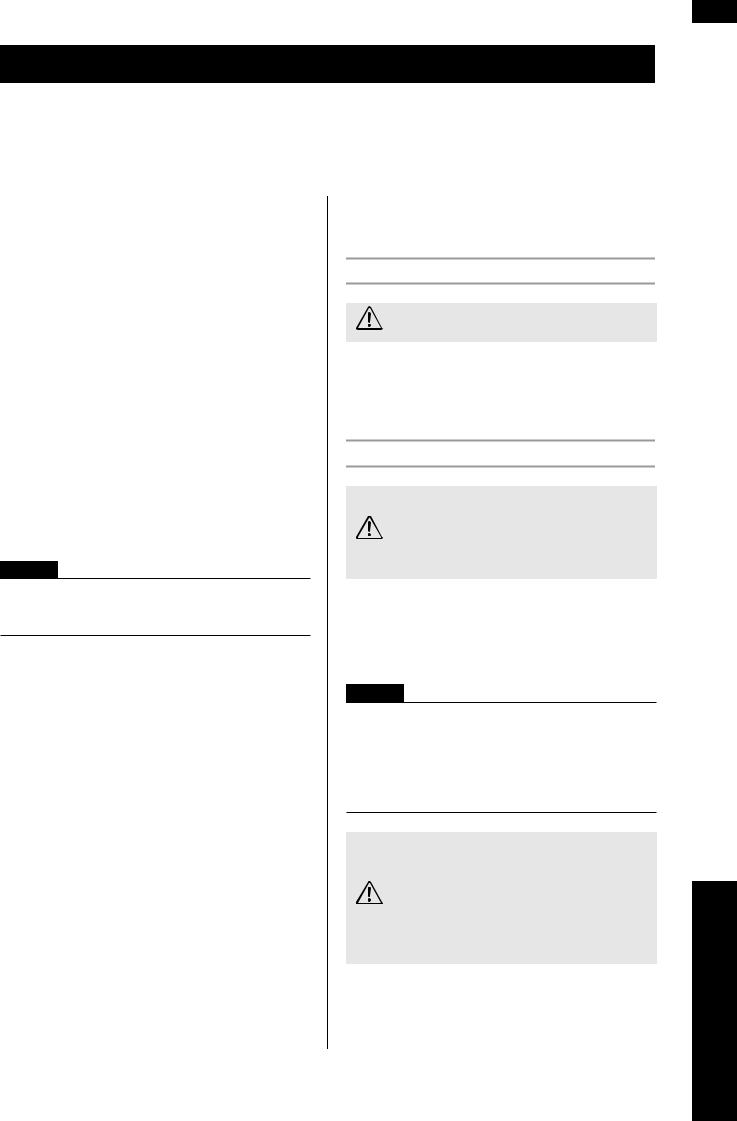
Foreword
Thank you for choosing a Yamaha DME8i-ES/DME8o-ES/DME4io-ES Digital Mixing Engine Satellite.
In order to take full advantage of the features and performance provided by the DME8i-ES/DME8o-ES/DME4io-ES, we urge you to read this owner’s manual thoroughly before connecting or using the unit. Keep this manual in a safe place for future reference.
Accessories (Please make sure the following items are included in the package.)
•DME8i-ES/DME8o-ES/DME4io-ES Owner’s Manual (this document)
•CD-ROM
•AC power cord
•Euroblock plug (16P) x 1
•Euroblock plug (3P) x 8
•Rubber feet x 4
Options
Control Panels
•ICP1 Intelligent Control Panel
•CP4SW Control Panel
•CP4SF Control Panel
•CP1SF Control Panel
NOTE
For more information on your Control Panel, refer to the owner’s manual that came with the Control Panel, as well as the DME Designer Owner’s Manual.
About the Product Names
In this manual, models DME8i-ES, DME8o-ES, and DME4io-ES are all called “DME Satellite,” and models DME64N and DME24N, DME8i-C/DME8o-C/ DME4io-C and the DME Satellite are categorized as the DME series.
About the Firmware Version
You can check the version number of the DME Satellite firmware by using the DME Designer application software. You can also download the latest firmware from the following Yamaha website.
http://www.yamahaproaudio.com/
Preparation
Connecting the AC power cord
Be sure to turn all devices OFF before connecting AC
mains power.
CAUTION
First plug the female-connector end of the AC cord into the [AC IN] socket on the rear panel of the DME Satellite, then plug the male plug into an appropriate AC mains outlet.
Be sure to use the voltage specified for the device.
Turning the power on and off
To prevent the initial power-on surge from generating a large noise spike or damaging your speaker system, turn
the devices on in the following order: audio sources, mixer
CAUTION (such as M7CL or PM5D), DME Satellite, and finally power amplifiers.
Reverse this order when turning power off.
1. Press the [POWER] switch to turn on the power to the DME Satellite.
2. Press the [POWER] switch again to turn off the power.
NOTE
The DME Satellite remembers scene settings when you turn off the power.
When you turn on the power to the DME Satellite, it will start up with the same scene settings.
You can use the “Last Mem. Resume” setting in DME Designer to set up the DME Satellite so that at the startup it will recall the scene selected before you turned off the power to the device.
•Do NOT turn off the power to the DME Satellite while it is receiving data from DME Designer or while it is
|
being manipulated from an external device. Otherwise, |
|
a malfunction may occur. |
• |
Even when the power switch is turned off, electricity is |
CAUTION |
still flowing to the product all the minimum level. |
|
When you are not using the product for a long time, |
|
make sure to unplug the power cord from the wall AC |
|
outlet. |
Foreword
|
|
|
|
Introduction to |
the DME Satellite |
|
|
|
|
Controls and |
Connectors |
|
|
|
|
Connecting to |
a Computer |
|
|
|
|
Audio I/O |
Connection |
|
|
|
|
Connecting to an |
External Device |
|
|
|
|
Other Functions |
|
|
|
|
|
References |
|
DME8i-ES/DME8o-ES/DME4io-ES Owner’s Manual |
7 |
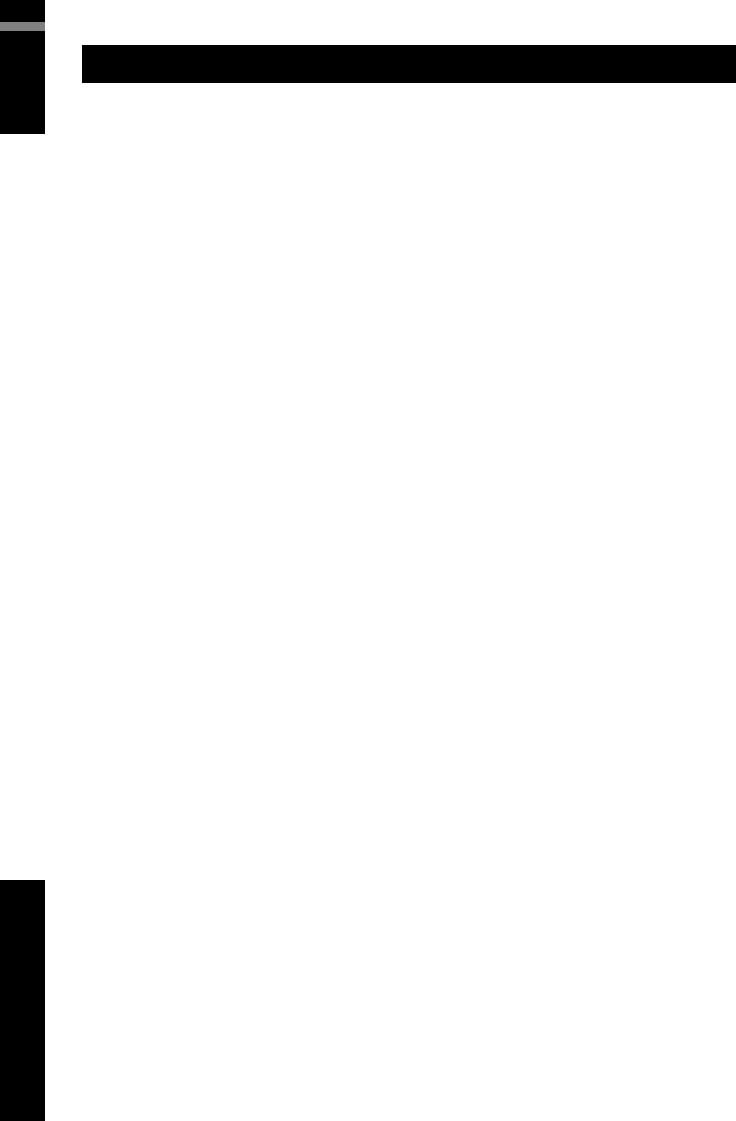
Foreword
|
|
Satellite DME the |
to Introduction |
|
|
|
|
|
|
Connectors |
and Controls |
|
|
|
|
Computer a |
Connecting |
|
to |
|
|
|
|
Connection |
I/O Audio |
|
|
|
|
Device External |
an to Connecting |
|
|
|
|
Functions Other |
|
|
|
|
|
References |
|
Introduction to the DME Satellite
Differences between DME8i-ES, DME8o-ES, and DME4io-ES
The differences between these three models are as follows:
■ DME8i-ES
This model features 8-channel analog inputs.
■ DME8o-ES
This model features 8-channel analog outputs.
■ DME4io-ES
This model features 4-channel analog inputs and 4-channel analog outputs.
DME Satellite Features
In addition to basic mixing and matrix output functions, the DME Satellite includes a equalizers, compressors, delay, etc. – that can be patched together via DME Designer to configure just about any audio system you need. The EtherSound connectors on the device enable you to remotely control analog inputs and outputs by transferring digital audio signals via a network.
The following steps summarize the process for setting up the DME Satellite for use: (For details, refer to the PDF file “DME Setup Manual” on the CD-ROM.)
1. Install USB-MIDI Driver, DME Designer and DME-N Network Driver.
2. Set up the network from DME Designer (page 19).
3. Connect devices.
•Network connection
Ethernet connection (page 20) USB connection (page 18)
•EtherSound connection (page 28)
In order to route inputs and outputs, you’ll need the “AVS-ESMonitor” application software made by the AuviTran SARL.
You can download this from the following website. http://www.auvitran.com/view.php?products_AVS-ESMonitor.php
•Analog connection (page 25)
•External device connection
Remote connection (page 26) GPI connection (page 30)
4.Make network settings on your computer.
5.Create a configuration using DME Designer, then transfer it to the DME Satellite.
8 |
DME8i-ES/DME8o-ES/DME4io-ES Owner’s Manual |

Introduction to the DME Satellite
Audio System Network
Multiple DME series units that are interconnected in a network via Ethernet function as a single audio system. In a DME audio system, a group of the same models that can be operated in sync is called a “device group;” audio processing divisions that accommodate multiple device groups are called “zones;” and the entire area serviced by the acoustic system is called an “area.”
Each device group always includes one DME series unit that functions as the “group master” and controls all other DME series units in the same device group.
If a computer is connected to the network, you can use the computer to control an entire device group via the group master.
Glossary for the DME Satellite
This section explains terminology specific to the DME Satellite.
Components and parameters
The individual audio processing modules (equalizers, compressors, etc.) are called “components.” External head amplifier control modules are also available as components.
Changing the parameters of components enables control over the operation of the components.
Configuration
A “configuration” is a complete set of components for constructing an audio system.
Each configuration determines the audio function(s) of the corresponding DME Satellite unit.
All parameter sets included with each component in a configuration are called “preset parameters.”
One DME Satellite unit has a number of configurations, and a configuration has a number of preset parameters.
User Defined buttons (User Defined parameters)
Assigning parameters to be User Defined parameters enables you to control the device from the ICP1 and the DME64N/DME24N.
Refer to the “DME Designer Owner’s Manual” for details.
Foreword
|
|
Introduction to |
the DME Satellite |
|
|
|
|
|
|
Controls and |
Connectors |
|
|
|
|
Connecting to |
a Computer |
|
|
|
|
Audio I/O |
Connection |
|
|
|
|
Connecting to an |
External Device |
|
|
|
|
Other Functions |
|
|
|
|
|
References |
|
DME8i-ES/DME8o-ES/DME4io-ES Owner’s Manual |
9 |
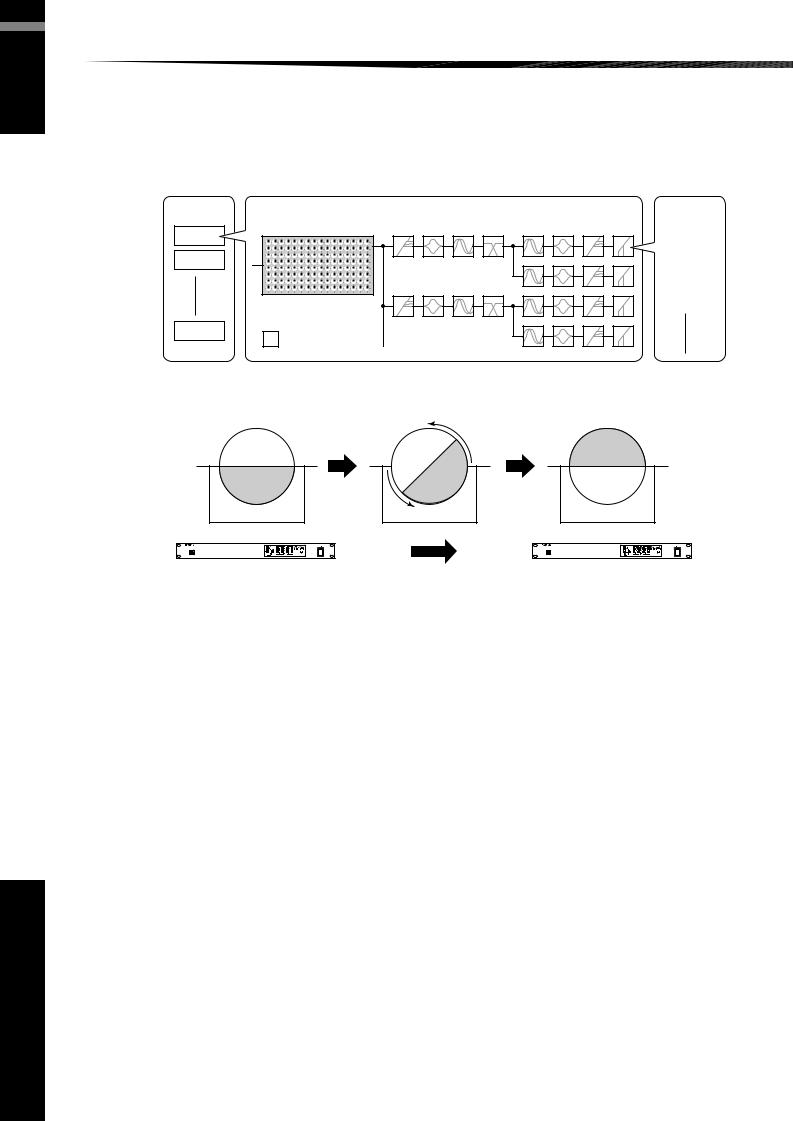
Foreword
|
|
Satellite DME the |
to Introduction |
|
|
|
|
|
|
Connectors |
and Controls |
|
|
|
|
Computer a |
Connecting |
|
to |
|
|
|
|
Connection |
I/O Audio |
|
|
|
|
Device External |
an to Connecting |
|
|
|
|
Functions Other |
|
|
|
|
|
References |
|
Introduction to the DME Satellite
Scene
A combination of all configuration and preset parameters is called a “scene.”
Scenes can be recalled from an ICP1, GPI device, other external controllers, DME64N/DME24N, or computer. Up to 999 scenes can be stored for each device group.
Scene structure
Scene |
Configuration |
Preset |
Matrix Mixer |
Parameter |
|
|
|
|
Scene 1 |
Ex.: Gate |
|
|
||
|
• |
Attack |
Scene 2 |
• Decay |
|
|
• Range |
|
|
• |
Threshold |
|
• |
Key in |
16 x 8 |
• |
Hold |
Scene 999
 Component
Component
Scene change
First Act |
Dark Change |
Second Act |
|
Band Set |
Band |
Play Set |
|
|
Set |
|
|
Play Set |
Play |
Band Set |
|
Set |
|||
|
|
||
Stage |
Stage |
Stage |
Scene 1 |
Scene Recall |
Scene 2 |
10 |
DME8i-ES/DME8o-ES/DME4io-ES Owner’s Manual |
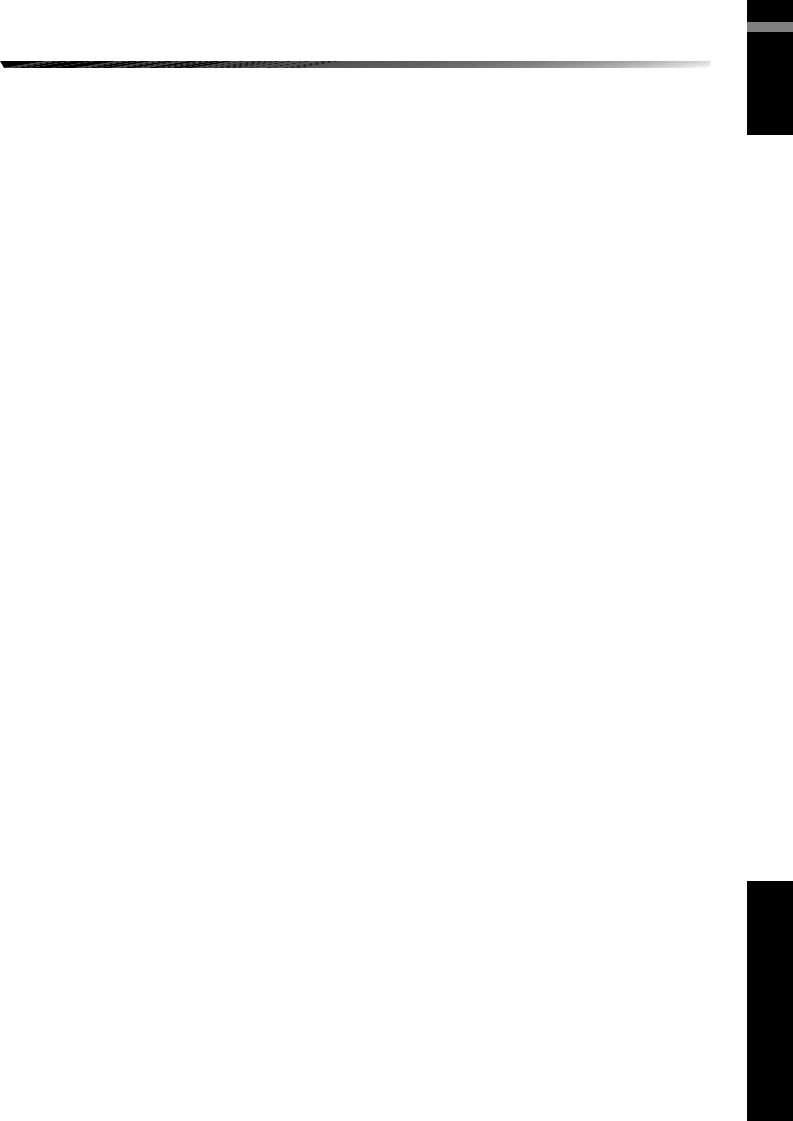
Introduction to the DME Satellite
Signal Types
DME Satellite audio system signals can be broadly categorized as follows.
1 Audio
Analog and digital signals are input and output between the DME Satellite, other DME series units, and other audio devices. Analog signals are input and output via the [INPUT]/[OUTPUT] jacks. Digital signals are input and output via the EtherSound jacks.
2 Control signals within a device group
Device group control signals control all DME series devices in the group. There are two types of device group control signals, as follows:
•Control signals between the computer and the group master DME series unit
•Control signals between the group master DME series unit and the other DME series units
You can use the DME Designer application to control the entire device group, such as sending components to the devices and setting the parameters as required.
3 Control signals between devices outside the device group
These signals provide communication and control between individual devices.
Included in this category are MIDI messages transferred between [USB] connectors, GPI signals transferred between [GPI] connectors, and remote head amp control signals handled via the [REMOTE] connector.
Type of signals handled by the DME Satellite
Connector |
Audio Signal |
Device Control |
Reference |
||
Page |
|||||
|
|
|
|
||
|
|
|
|
|
|
|
|
• |
Control signals between computer and DME |
|
|
[USB] Connector |
— |
|
Satellite |
page 18 |
|
|
|
• |
MIDI messages |
|
|
|
|
|
|
|
|
|
|
• |
Control signals between computer and DME |
|
|
|
|
|
Satellite |
page 20 |
|
[NETWORK] Connector |
— |
• |
Control signals between DME Satellites |
||
page 29 |
|||||
|
|
• |
Control signals with a controller such as an |
||
|
|
|
|||
|
|
|
AMX or Crestron |
|
|
|
|
|
|
|
|
|
Up to 16 channels of input |
• |
Internal head amp control signals with a |
page 24 |
|
EtherSound Connector |
|
digital mixer |
|||
and output. |
|
page 28 |
|||
|
• |
Control signals with AVS-ESMonitor |
|||
|
|
|
|||
|
|
|
|
||
[GPI] Connector |
— |
GPI control signals between GPI device (GPI |
page 30 |
||
controller, etc.) and DME series unit |
|||||
|
|
|
|||
|
|
|
|
|
|
|
|
• |
Control signals to/from an external device |
|
|
|
|
|
(such as AD8HR head amplifier) |
|
|
|
|
• |
Control signals for a digital mixer and |
page 26 |
|
[REMOTE] Connector |
— |
|
internal head amp |
||
|
|
• |
Control signals with a controller such as an |
|
|
|
|
|
AMX or Crestron |
|
|
|
|
• |
MIDI messages |
|
|
|
|
|
|
|
|
[INPUT]/[OUTPUT] |
The number of I/O channels |
|
— |
page 25 |
|
Connectors (audio in/out) |
depends on model. |
|
|||
|
|
|
|||
|
|
|
|
|
|
Foreword
|
|
Introduction to |
the DME Satellite |
|
|
|
|
|
|
Controls and |
Connectors |
|
|
|
|
Connecting to |
a Computer |
|
|
|
|
Audio I/O |
Connection |
|
|
|
|
Connecting to an |
External Device |
|
|
|
|
Other Functions |
|
|
|
|
|
References |
|
DME8i-ES/DME8o-ES/DME4io-ES Owner’s Manual |
11 |

Foreword
|
|
Satellite DME the |
to Introduction |
|
|
|
|
|
|
Connectors |
and Controls |
|
|
|
|
Computer a |
Connecting |
|
to |
|
|
|
|
Connection |
I/O Audio |
|
|
|
|
Device External |
an to Connecting |
|
|
|
|
Functions Other |
|
|
|
|
|
References |
|
Introduction to the DME Satellite
System Examples
Multiple DME Satellite units: Large-scale system
Space A |
Space B |
|
|
Analog In |
|
Computer |
DME8i-ES |
|
ICP1 |
||
|
Analog In |
|
|
DME8i-ES |
|
|
Hub |
|
|
Analog In |
|
|
DME4io-ES |
|
|
Analog Out |
|
Hub |
|
|
M7CL |
|
|
|
Space C |
|
|
DME8o-ES |
|
EtherSound |
|
|
compatible |
Analog Out |
|
I/O card × 2 |
DME8o-ES |
|
Primary |
||
|
||
Master |
Analog Out |
|
|
||
|
Hub |
|
|
DME8o-ES |
|
|
Analog Out |
Space D |
Analog In |
|
DME8i-ES |
|
Analog In |
|
DME4io-ES |
Hub |
Analog Out |
|
|
DME8o-ES |
EtherSound |
|
Ethernet Control |
Analog Out |
Analog Audio |
|
NOTE
•Connect the computer to the [IN] connector of the first daisy-chained EtherSound device. This connector can also be used in common with the same network as Ethernet Control.
•Units following the [OUT] connector of the first EtherSound device cannot be used in common with the same network as Ethernet Control.
12 |
DME8i-ES/DME8o-ES/DME4io-ES Owner’s Manual |
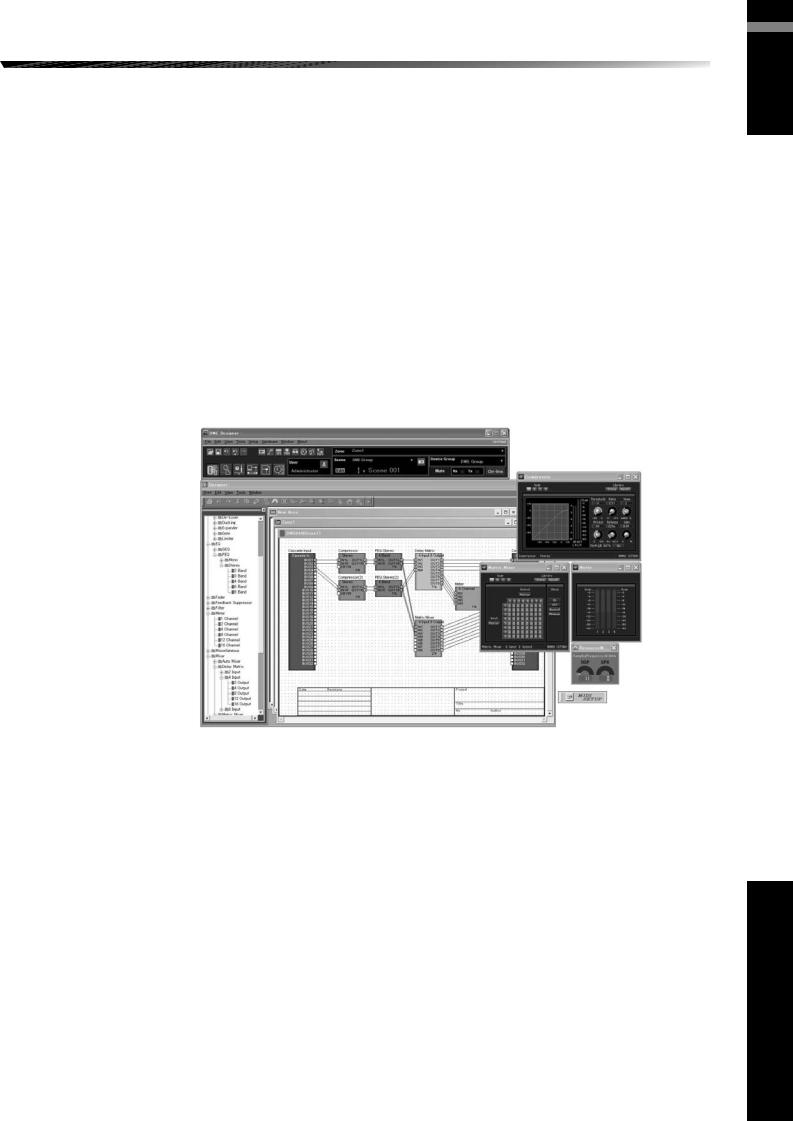
Introduction to the DME Satellite
About DME Designer
DME Designer software enables you to integrate, configure, and control the DME series system from a connected computer.
You can build the DME series audio system using graphic blocks in DME Designer that are displayed on the computer monitor.
The DME series settings, configuration, and parameter data are transferred from the computer to the DME series unit via the USB or Ethernet connection.
DME series settings, configuration, and parameter data is sent via USB or Ethernet to the connected DME series unit. After the data is transmitted, you can disconnect the DME series unit from the computer and use it as an independent processor.
You can also connect it to a computer and control it in realtime from DME Designer.
If multiple DME series units are connected in the network, DME Designer enables you to build a configuration that includes those units.
Refer to the “Connecting to a Computer” (page 18) for more information on connecting a computer to the DME Satellite. For details on how to install DME Designer and the drivers that are required for connection, refer to the PDF file “DME Setup Manual” included on the CD-ROM.
Refer to the DME Designer Owner’s Manual for setup and operation instructions.
Foreword
|
|
Introduction to |
the DME Satellite |
|
|
|
|
|
|
Controls and |
Connectors |
|
|
|
|
Connecting to |
a Computer |
|
|
|
|
Audio I/O |
Connection |
|
|
|
|
Connecting to an |
External Device |
|
|
|
|
Other Functions |
|
|
|
|
|
References |
|
DME8i-ES/DME8o-ES/DME4io-ES Owner’s Manual |
13 |
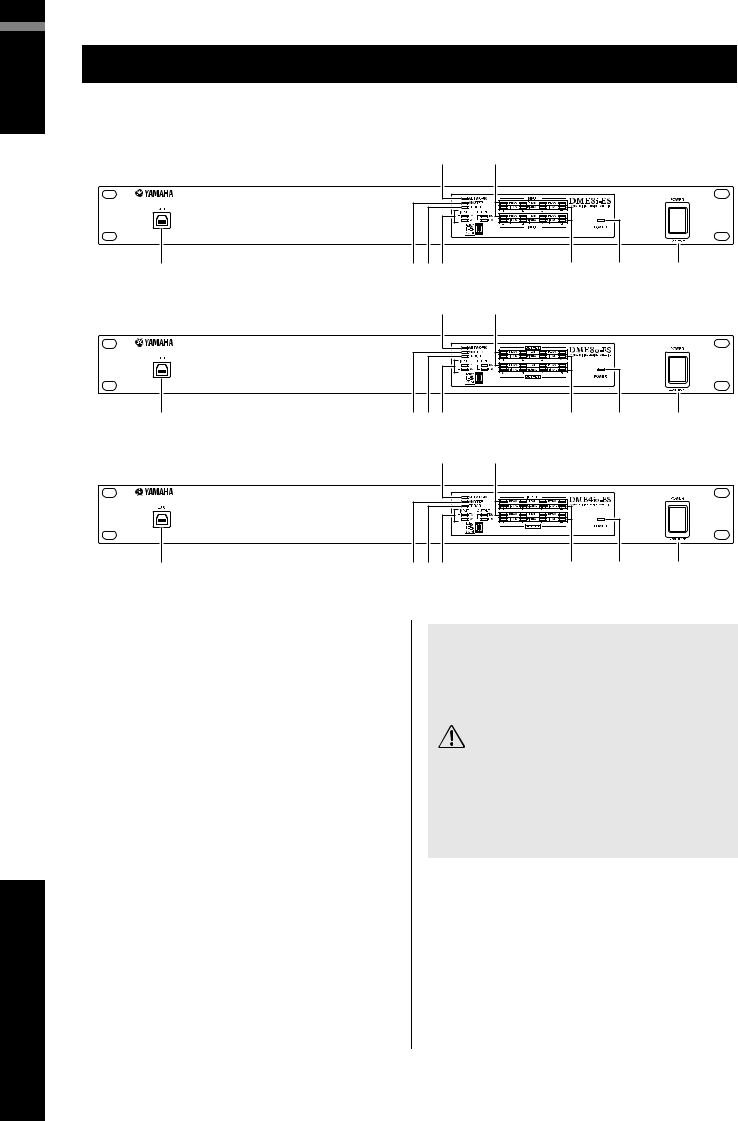
Foreword
|
|
|
|
Satellite DME the |
to Introduction |
|
|
Connectors |
and Controls |
|
|
|
|
|
|
Computer a |
Connecting |
|
to |
|
|
|
|
Connection |
I/O Audio |
|
|
|
|
Device External |
an to Connecting |
|
|
|
|
Functions Other |
|
|
|
|
|
References |
|
Controls and Connectors
Front Panel
DME8i-ES
1
DME8o-ES
2 |
6 |
345 |
7 |
8 |
9 |
26
1
DME4io-ES
1
345 |
7 |
8 |
9 |
2 |
6 |
|
|
345 |
7 |
8 |
9 |
1 [USB] Connector
Use this connector to connect the DME Satellite to the computer’s USB port. If you plan to use a USB connection, you must first install the USB-MIDI Driver on your computer. Refer to the “DME Setup Manual” (PDF file) for installation instructions.
Be sure to follow the procedure below when you make a USB connection with a computer. Otherwise, the computer and/ or DME Satellite may freeze, resulting in damages or loss of data.
If the computer or DME Satellite freezes, turn the power to the DME Satellite off and then on, then restart the computer.
•Before you connect the DME Satellite to the computer via USB, cancel the computer’s energy saving mode (such as Suspend, Sleep, or Stand-by mode).
•Before turning on the power to the DME Satellite, first connect its [USB] connector to the computer’s USB port.
•Before turning the power to the unit on or off, and
before connecting or disconnecting the USB cable, take
the following actions:
CAUTION
-Quit all open applications.
-Make sure that the DME Satellite is NOT transferring any data.
•Be sure to wait six seconds or more between turning the power to the unit on and then off (or off and then on), or between connecting and disconnecting (or vice versa) the USB cable.
2 [NETWORK] Indicator
Lights orange while data communication is occurring via the [USB] or [NETWORK] connector.
3 [MASTER] Indicator
Lights green when the device is operating as the group master. The indicator is turned off if the device is operating as a slave.
You can assign the group master in DME Designer.
14 |
DME8i-ES/DME8o-ES/DME4io-ES Owner’s Manual |

Controls and Connectors
4 [ERROR] Indicator
Lights when an error occurs. The [PEAK] indicators reflect the type of error. The [ERROR] indicator flashes when the battery charge is getting low.
5 [TX/RX] Indicator
These indicate the communication status of the signals from the EtherSound connector to the network. The transmission status is shown by the [TX] indicator, and the reception status by the [RX] indicator. The indicator will blink when signals are being sent correctly. The indicator will be dark if no cable is connected to the EtherSound connector, or if communication is not occurring successfully.
INPUT: Indicates the communication status of the EtherSound [IN] connector.
OUTPUT: Indicates the communication status of the EtherSound [OUT] connector.
6 [PEAK] Indicators
Light red when the signal level at the corresponding built-in analog audio inputs or outputs ([INPUT] or [OUTPUT] connectors) reaches or exceeds -3 dBFS. They also indicate an error number or status.
7 [SIGNAL] Indicators
Light green when the signal level at the corresponding builtin analog audio inputs or outputs ([INPUT] or [OUTPUT] connectors) reaches or exceeds -40 dBFS. They also indicate the status, for example, of the initialization process.
NOTE
Remove the transparent protective film that was applied to the indicator panel prior to shipment from the factory.
8 [POWER] Indicator
This will light when you turn the power on.
9 [POWER] Switch
Turns main power to the device on and off. The DME Satellite will start up with the same scene settings that were active when it shut down. You can use the “Last Mem.
Resume” setting in DME Designer to set up the DME Satellite so that at startup it will recall the scene selected before you turned off the power to the device.
Foreword
|
|
|
|
Introduction to |
the DME Satellite |
|
|
Controls and |
Connectors |
|
|
|
|
|
|
Connecting to |
a Computer |
|
|
|
|
Audio I/O |
Connection |
|
|
|
|
Connecting to an |
External Device |
|
|
|
|
Other Functions |
|
|
|
|
|
References |
|
DME8i-ES/DME8o-ES/DME4io-ES Owner’s Manual |
15 |
